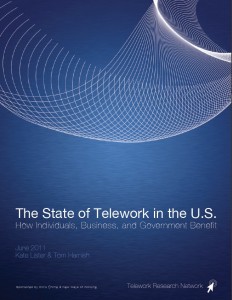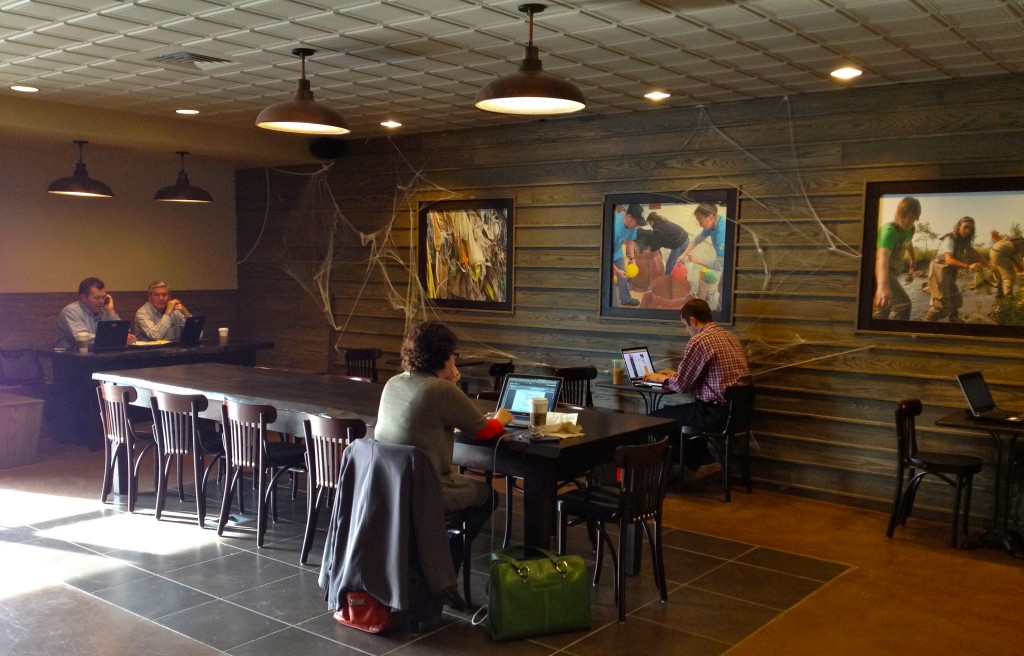 While 63 million Americans hold jobs that could be done at home, fewer than 3 million actually work away from the office most of the time, according to research we did for Citrix Online, a division of Citrix Systems, Inc. The research analyzed statistics from public and private sources, such as the U.S. Census Bureau and Bureau of Labor Statistics, to build a complete image of the state of virtual working in the United States. The results paint a dismal picture. Employee demand to workshift far outstrips their opportunity to do so, highlighting the persistence of outdated management practices and antiquated attitudes towards oversight and eligibility.
While 63 million Americans hold jobs that could be done at home, fewer than 3 million actually work away from the office most of the time, according to research we did for Citrix Online, a division of Citrix Systems, Inc. The research analyzed statistics from public and private sources, such as the U.S. Census Bureau and Bureau of Labor Statistics, to build a complete image of the state of virtual working in the United States. The results paint a dismal picture. Employee demand to workshift far outstrips their opportunity to do so, highlighting the persistence of outdated management practices and antiquated attitudes towards oversight and eligibility.
Here’s some of what we discovered:
- A typical workshifter is 49 years old, college educated and in a management, senior employee or professional role.
- Over 75% of employees who work from home earn over $65,000 per year, putting them in the upper 80 percentile relative to all employees.
- Demand Outpaces Supply
- 63 million U.S. employees hold jobs that could be done at home at least part of the time, yet fewer than 3 million, 2.3% of the population, get the chance to work virtually on a regular basis.
- Almost 80% of all employees would work from home if they could.
- Will Trade Money for Freedom
- More than one third of non-teleworkers surveyed by WorldatWork would take a pay cut to be able to have more independence in where and how they work.
- Commute Time Is Not a Factor
- The study found no correlation between cities with the most congestion or longest commute times and number of workshifters.
- The San Diego metro area has the highest concentration of people who work at home, 4.2%, while Detroit and Houston have the lowest, each with 1.8%. The New York metro area rounds out the bottom three, with 2.1%.
As business becomes more global and workforces more dispersed, companies will have little choice but to implement virtual work practices. Those who operate that way now will have a significant head start, not to mention the pick of talent from around the globe, instead of just their own backyard.
Ongoing concerns about the global economy are causing companies to keep a tight grip on hiring. For growing companies, this can result in more work for those in employment, creating the need to work longer. Virtual working offers people a better work-life balance by letting them take charge of how they manage competing priorities in a given period of time.
Workshifting, the ability to work where it is most optimal rather than confined to an office or specific location, is much more than a perk; it is a business advantage. Implemented correctly, it is a means to diversify the organization, attract new talent, increase productivity and enhance sustainability.
Despite being the birthplace of much of the technical innovation that makes “work anywhere” possible, the U.S. is stubbornly lagging behind other parts of the world when it comes to workshifting: in Canada, 3.2% of the population teleworks regularly, and in the United Kingdom the figure is even higher at 5.6%, compared to just 2.3% in the U.S.
Mobile and collaboration technology exists to enable people to work anytime, anywhere. Outdated management thinking is often the only serious obstacle to more flexible and virtual work practices.
“The reality is that managers simply don’t trust their employees to work untethered. That’s not going to change until companies start measuring performance based on results, rather than the number of hours someone sits at their desk. Management gurus have been telling us for decades that results-based management is the key to maximizing employee potential; and it’s true whether employees are a hundred feet or a hundred miles away.” - Kate Lister, president, Telework Research Network
“The benefits of workshifting have been known for quite some time now, so it’s easy to assume that everyone is doing it these days, but the truth of the matter is pretty sobering and more than a little disappointing. Despite much evidence to the contrary, it seems old-fashioned notions that work must be seen to be done still prevail. And by offering workshifting merely as a perk for management, companies are missing out on some of the biggest benefits of flexible working. - Brett Caine, President, Citrix Onlints.




 While 63 million Americans hold jobs that could be done at home, fewer than 3 million actually work away from the office most of the time, according to research we did for Citrix Online, a division of Citrix Systems, Inc. The research analyzed statistics from public and private sources, such as the U.S. Census Bureau and Bureau of Labor Statistics, to build a complete image of the state of virtual working in the United States. The results paint a dismal picture. Employee demand to workshift far outstrips their opportunity to do so, highlighting the persistence of outdated management practices and antiquated attitudes towards oversight and eligibility.
While 63 million Americans hold jobs that could be done at home, fewer than 3 million actually work away from the office most of the time, according to research we did for Citrix Online, a division of Citrix Systems, Inc. The research analyzed statistics from public and private sources, such as the U.S. Census Bureau and Bureau of Labor Statistics, to build a complete image of the state of virtual working in the United States. The results paint a dismal picture. Employee demand to workshift far outstrips their opportunity to do so, highlighting the persistence of outdated management practices and antiquated attitudes towards oversight and eligibility.






